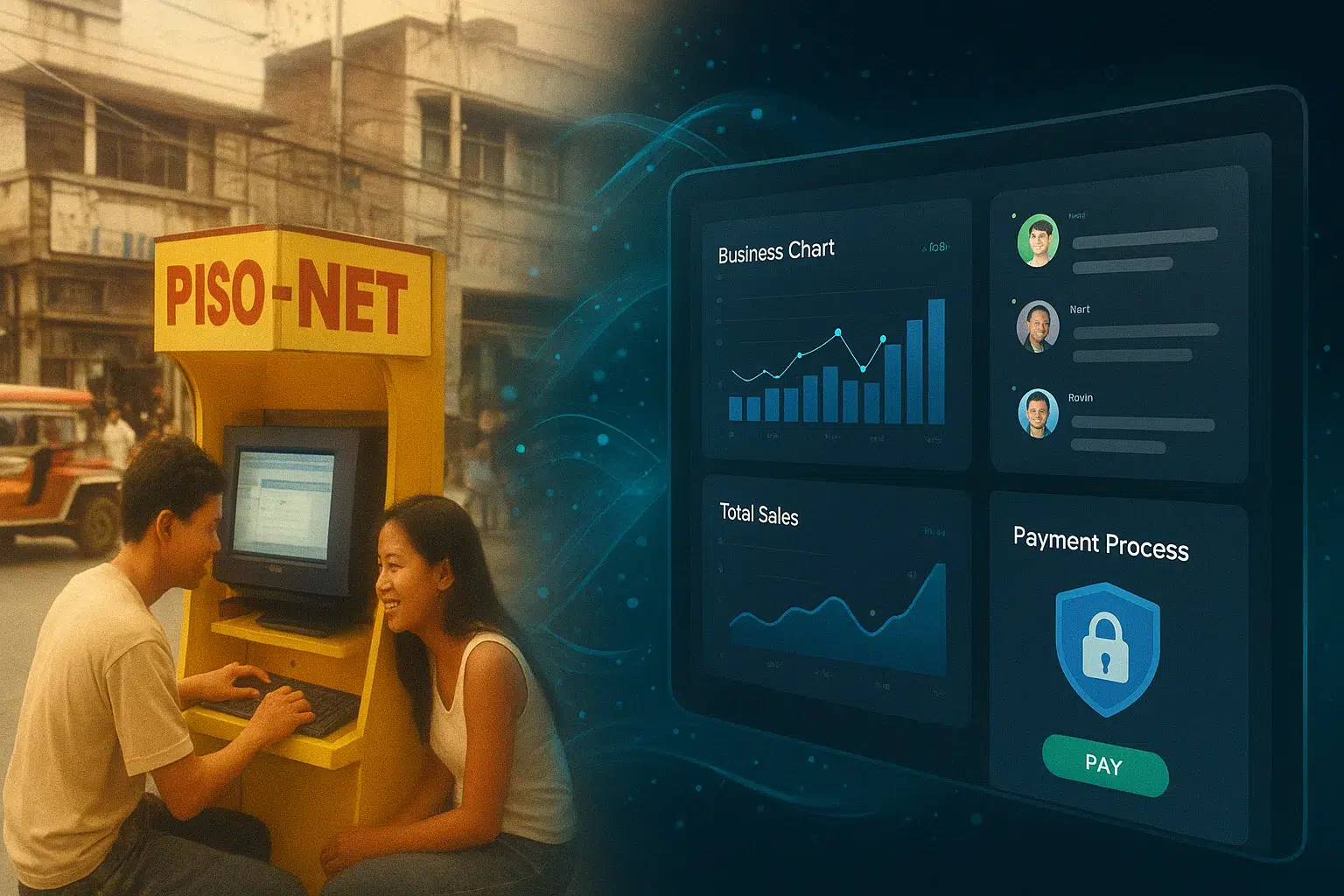Introduction: The Dual Legacy of Pasonet
The name Pasonet is a complex and captivating keyword in the history of digital connectivity. For millions in the Philippines, it conjures an instant wave of nostalgia: the sound of a coin dropping into a slot, marking the start of a precious few minutes of internet access in the late 1990s. This original Pasonet was a cultural phenomenon, a revolutionary democratizer of the web, and a key architect of the early Filipino digital landscape.
However, a modern search for “Pasonet” reveals a second, distinct identity—or rather, a new set of entities carrying the torch of its core philosophy. Today, “Pasonet” is also used to describe cutting-edge digital platforms: a comprehensive Business Collaboration and Workflow Automation suite and an advanced Secure Online Payment Gateway.
This detailed article will delve into the full, rich story of the Pasonet brand, tracing its revolutionary origins as a physical, coin-operated network and exploring how its spirit of accessible, efficient, and secure digital connection has been reborn in the advanced digital solutions of the modern era.
Part I: The Original Pasonet – A Filipino Digital Revolution (Late 1990s – Early 2000s)
To understand the enduring significance of Pasonet, one must travel back to the late 1990s in the Philippines. At a time when home internet connections were expensive, unreliable, and often limited to a dial-up service, the vast majority of Filipinos—particularly students, workers, and those in underserved communities—were effectively locked out of the nascent World Wide Web.
The Innovation of the Coin-Operated Kiosk
Pasonet’s genius lay in its simplicity: it introduced coin-operated internet kiosks. This innovation was a game-changer, shattering the cost and infrastructure barriers that prevented mass adoption of the internet.
- Affordable Connectivity: Users could pay for internet access by the minute, often with a single coin (a piso, hence the name’s likely origin, piso-net), making it an expenditure on par with a soda or a snack. This “pay-as-you-go” model was the ultimate form of digital democratization.
- Widespread Accessibility: The kiosks were strategically located in public spaces—street corners, sari-sari stores (local convenience shops), and internet cafes—bringing the web directly to the community. Pasonet booths became a fixture of the urban and even some rural landscapes.
- A Cultural Hub: These booths were more than just access points; they became social and cultural hubs. They were the primary means for a generation of Filipinos to experience the first wave of digital life: checking email, exploring early chat rooms, engaging in online gaming, and accessing digital information for education. Pasonet fostered a new, vibrant digital literacy.
The Rise, Peak, and Eventual Decline
The coin-op internet model peaked in the early 2000s, serving as a crucial bridge between the era of no-internet and the era of ubiquitous mobile data. However, as with all pioneering technologies, its reign was challenged by newer, more robust, and more convenient solutions.
The primary factors contributing to the decline of the original Pasonet model were:
- The Rise of Broadband: As fixed-line and cable internet providers began offering more reliable, faster, and eventually more affordable unlimited monthly plans, the need for time-restricted, coin-operated access diminished.
- Mobile Internet Revolution: The proliferation of affordable smartphones and mobile data packages delivered a final blow. Users could now access the internet anytime, anywhere, in the palm of their hand, rendering the stationary, coin-fed booth obsolete.
- Competition from Internet Cafes: Dedicated internet cafes offered superior equipment, a better environment, and often unlimited time for a fixed, low price, drawing users away from the basic kiosks.
Despite its decline, the legacy of the original Pasonet is woven into the fabric of the Philippines’ digital history. It laid the foundation for the country to become one of the most digitally engaged nations in the world, proving that a model focused on accessible, bite-sized, and convenient connectivity could spark a massive societal shift.
Part II: The Modern Rebirth – Pasonet in the Enterprise and FinTech Space
Today, the spirit of “Pasonet”—the idea of a unified, highly efficient, and easily accessible system—has resurfaced in the realm of B2B and FinTech solutions. While likely distinct corporate entities, these platforms embody the original ethos of democratizing access, but for the modern business user.
1. Pasonet as a Business Collaboration and Workflow Automation Platform
The modern business environment is plagued by software fragmentation, leading to silos and inefficiency. The “Pasonet” described in current tech literature aims to solve this by offering an all-in-one, cutting-edge solution for team collaboration.
Key Features and SEO Focus:
- Streamlined Communication: It moves beyond scattered emails and multiple chat apps. Pasonet centralizes all internal communications—real-time chat, video conferencing, and threaded discussions—within a single, user-friendly interface. This dramatically boosts productivity by ensuring team collaboration is fluid and transparent.
- Workflow Automation: The platform automates repetitive, mundane administrative tasks. By creating automated workflows for processes like approvals, data entry, and project initiation, Pasonet enables businesses to achieve significant cost savings and frees up employees to focus on strategic, high-value work.
- Centralized Project Management: The platform includes robust tools for task assignment, progress tracking (using visual aids like Kanban boards or Gantt charts), and deadline management. This central hub fosters real-time accountability and transparency across all ongoing projects, making it a powerful project management tool.
- Seamless Integration: A major value proposition is its ability to integrate effortlessly with existing business tools, such as CRM, accounting systems, and cloud storage. This connectivity ensures a unified digital workspace, eliminating the need to constantly switch between applications, thereby enhancing operational efficiency.
- Data Security and Compliance: Recognizing the paramount importance of data protection, the platform leverages advanced data encryption and compliance with international standards. This focus on security allows businesses to collaborate globally with confidence, protecting sensitive information from cyber threats.
2. Pasonet as a Secure Online Payment Gateway
The second modern interpretation positions Pasonet as a crucial player in the financial technology (FinTech) sector. Here, the platform’s mission is to offer a seamless, reliable, and secure method for processing online payments.
Key Features and SEO Focus:
- Secure Transactions: This Pasonet utilizes advanced encryption technologies, including SSL/TLS and tokenization, to ensure a high level of secure online payment processing. Compliance with industry standards like PCI DSS is a core component, mitigating the risk of fraud and unauthorized access.
- Global Accessibility and Multi-Platform Support: True to the original spirit of accessibility, the payment gateway is designed for global reach, supporting transactions across multiple currencies and international borders. It also offers multi-platform compatibility, allowing businesses to accept payments via desktop, mobile apps, and e-commerce websites seamlessly.
- Fast Processing and Low Fees: It focuses on fast processing and competitive, cost-effective transaction fees, appealing to both large e-commerce sites and small-to-medium enterprises (SMEs). This is a modern echo of the original Pasonet’s low-cost entry model.
- Integration with Financial Ecosystems: The gateway works by securely linking various financial instruments, including major credit/debit cards, bank accounts, and popular mobile wallets, effectively creating a one-stop-shop for digital finance management.
Conclusion: The Enduring Ethos of Pasonet
The name Pasonet represents more than just a historical footnote or a modern software brand; it is a testament to the powerful, transformative impact of Accessible Digital Technology.
The 1990s coin-operated kiosks democratized internet access for a nation, proving that low-cost, convenient micro-transactions could unlock global opportunity. Today’s modern “Pasonet” solutions—be they for enterprise collaboration or global payment processing—continue this legacy. They aim to democratize productivity and financial transactions by:
- Lowering Barriers: Offering all-in-one solutions that reduce the overhead and complexity of managing multiple systems.
- Prioritizing Efficiency: Automating the tedious and time-consuming aspects of business operations.
- Ensuring Security: Providing the robust data protection necessary for modern digital trust.
From a street-corner booth to a cloud-based application, the Pasonet journey is a compelling case study in the evolution of connectivity. It underscores a timeless principle: the most revolutionary technologies are those that are designed to be accessible, efficient, and reliable for everyone. By focusing on these core values, the name Pasonet remains a powerful, relevant keyword in the ever-evolving narrative of the digital world.



